
A magnificent photo of sea, swell, sky, and a monk seal swimming over a coral reef bottom in the Northwest Hawaiian Islands. (NOAA/PIFSC/HMSRP)

A magnificent photo of sea, swell, sky, and a monk seal swimming over a coral reef bottom in the Northwest Hawaiian Islands. (NOAA/PIFSC/HMSRP)
Whether directly or indirectly, human beings are destroying ocean ecosystems at an alarming rate. Already, 10% of the world’s reefs have been completely destroyed, and in the worst cases, such as in the Philippines where over 70% of reefs have been destroyed, only 5% can be said to be in good condition. In order to survive, corals need access to sunlight and water temperatures of 68 to 90° F. However, due to global warming and the melting ice caps water temperatures are decreasing, and due to pollution water quality and clarity is decreasing, therefore limiting the access to sunlight.

These changes in the natural variations of the reefs’ environments have caused a phenomenon known as coral bleaching, which is devastating to reefs. Coral bleaching causes a reduction in photosynthetic pigment concentrations, which results in the destruction of major reef tracts and the extinction of many coral species. Both the frequency and extent of coral bleaching worldwide has seen a rapid increase in the past 20 years. More directly, overfishing and careless tourism are also destroying our oceans corals. Earlier this year, we saw the trending #10yearchallenge which many ocean activists such as photographer Jim Abernethy took as an opportunity to post on social media and reveal the extreme deterioration that has taken place in our oceans over the last 10 years.
We need coral reefs, however, corals are stressed and, more recently, facing risk of extinction. Coral reefs sustain and protect the most diverse ecosystems on the planet, they provide medicine, protect coastal communities, serve as a nursery for a quarter of the world’s fish and 8 million species, drive tourism and support jobs for millions of people around the world. The Great Barrier Reef in Australia alone for example generates more than $1.5 billion every year from various industries including fishing and tourism. While individual corals build reefs over thousands of years, environmental stressors and physical damage can destroy a reef in less than a decade, leading to devastating and irreversible effects.
The health, management and conservation of coral reefs, is a fundamental issue currently facing humanity, presenting a real challenge to sustainability. Historically, coral conservationists have focused their efforts on protecting these invaluable marine resources from direct environmental threats. While these efforts continue, researchers are now also looking at ways to tackle coral reef restoration more proactively. Conservationists have developed a technique to grow corals in nurseries and repopulate damaged reefs. Coral “nurseries” nurture small, found pieces of coral on underwater structures, as seen in the picture below, until they can be replanted on existing reefs, stimulating recovery of these ecosystems. The slow growth rate of corals makes recovery from mass death events, such as bleaching or disease, challenging, but, in low stress environments of a nursery, conservationists can grow corals much faster, giving the reefs a fighting chance. Most importantly perhaps, coral nurseries allow conservationists to manage the diversity coral populations. Fostering diversity among corals means the overall population will be more resilient to changes in its environment, such as warming ocean waters.

One group that has made significant progress through coral nurseries is The National Oceanic and Atmospheric Administration (NOAA). In the waters around Florida, Puerto Rico, and the U.S. Virgin Islands, NOAA works with a number of partners in various capacities to maintain 27 coral nurseries. These underwater safe havens serve a dual function; not only do they provide a stable environment for injured corals to recuperate, but they also produce thousands of healthy young corals, ready to be transplanted into previously devastated areas.
In most cases, unhealthy corals are first taken to a lab where they are nurtured before being translated to coral nurseries in the ocean, however, Hawaii’s Division of Aquatic Resources recently established a small-scale pilot coral nursery to test a new technique on the east coast of Oahu in Kaneohe Bay. The project aims to determine the effectiveness of in situ, or “in-the-field,” coral nurseries, here, the damaged coral fragments are directly translated to coral nurseries in the ocean where the environment can not be artificially manipulated.
Every year, the NOAA alone reintroduces over 2000 healthy corals back to the sea floor. In the image below we can see a growing and thriving transplanted elkhorn coral that was re-introduced near Vega Baja in Puerto Rico. The first image on the left was taken in 2009 when the coral was first re-introduced to the ocean, the middle image was taken in 2010 and the final one on the right in 2014. This image shows the increased speed by which corals that have been in coral nurseries grow in comparison to wild corals and also demonstrates how quickly reef ecosystems can form around healthy corals as between the 5 years we can already see more life on the ocean floor around the coral.

Even though coral nurseries started out as a way to rebuild reefs that had been damaged, the vast investment they have received has allowed them to grow beyond their initial aims. Today, researchers are looking for ways to actively build the resilience of corals through coral nurseries in the ocean and in the lab. Scientists want to know what factors allow corals to adapt to a changing climate and how they might intervene to help the corals. If achieved, this can create a solution to the changing ocean temperatures in the future and protect other corals from the death they are currently facing.
Although much progress has been done but groups such as the European Union, the United Nations, International Maritime Organization and many others to implement stricter laws and regulations to protect our oceans, coral nurseries are still not widely known about or implement even though they provide a relatively low scale and affordable solution. It is extremely important to protect our oceans from further damage but coral nurseries provide us with the tools to also restore corals that have already been damaged and we must take advantage of this opportunity.